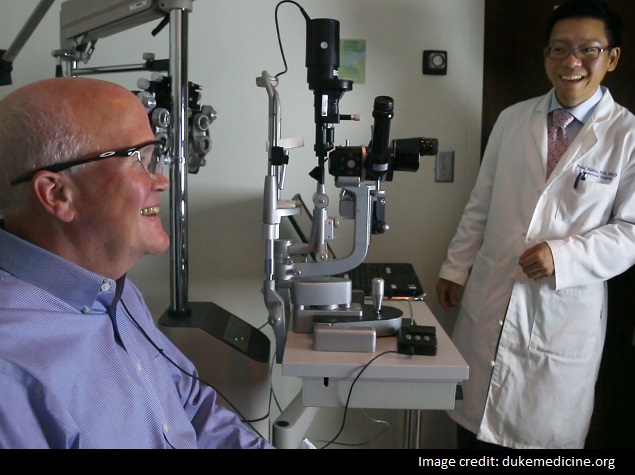- Home
- Science
- Science News
- Bionic Eye Allows Blind Man to 'See' for the First Time in 33 Years
Bionic Eye Allows Blind Man to 'See' for the First Time in 33 Years

Larry Hester was diagnosed with retinitis pigmentosa when he was in his early 30s. At the time, the degenerative disease that would rob his sight was poorly understood, and there were no known treatments, researchers said.
On October 1, 2014, Hester became only the seventh person in the US to have a so-called bionic eye - an Argus II Retinal Prosthesis Device - activated as a visual aid to send light signals to his brain.
The device incorporates technology initially developed by researchers at the Duke Eye Centre; its sophisticated features were further enhanced and marketed by a company called Second Sight Medical Products.
Using wireless technology, a sensor is implanted in the eye to pick up light signals sent from a camera mounted on special eyeglasses.
Paul Hahn, a retinal surgeon at the Duke Eye Centre, implanted the sensor on September 10, and activated the device three weeks later - to the sheer delight of Hester and his family.
Hahn cautioned that the device will not restore normal eyesight, but instead provide a visual aid that could help Hester distinguish a door from a wall, or a crosswalk painted in a roadway.
Hester describes seeing flashes of light that are more intense when he aims the camera at lights or light-coloured objects.
During a clinic visit, Hester described "seeing" sights he had long believed were past memories - a white duck swimming in a pond, the harvest moon, his wife's yellow chrysanthemums.
Hester's wife, Jerry, said her most cherished moment came while they were watching a football game. She was sitting in a dark chair, and her skin was enough of a contrast that Hester could see flashes. He reached out and touched her face.
Get your daily dose of tech news, reviews, and insights, in under 80 characters on Gadgets 360 Turbo. Connect with fellow tech lovers on our Forum. Follow us on X, Facebook, WhatsApp, Threads and Google News for instant updates. Catch all the action on our YouTube channel.
- Samsung Galaxy Unpacked 2025
- ChatGPT
- Redmi Note 14 Pro+
- iPhone 16
- Apple Vision Pro
- Oneplus 12
- OnePlus Nord CE 3 Lite 5G
- iPhone 13
- Xiaomi 14 Pro
- Oppo Find N3
- Tecno Spark Go (2023)
- Realme V30
- Best Phones Under 25000
- Samsung Galaxy S24 Series
- Cryptocurrency
- iQoo 12
- Samsung Galaxy S24 Ultra
- Giottus
- Samsung Galaxy Z Flip 5
- Apple 'Scary Fast'
- Housefull 5
- GoPro Hero 12 Black Review
- Invincible Season 2
- JioGlass
- HD Ready TV
- Laptop Under 50000
- Smartwatch Under 10000
- Latest Mobile Phones
- Compare Phones
- Realme P4x 5G
- OnePlus Ace 6T
- OPPO A6x 5G
- Samsung Galaxy Z TriFold
- Poco F8 Ultra
- Poco F8 Pro
- Huawei Mate 80 RS Master Edition
- Huawei Mate 80 Pro Max
- Asus ProArt P16
- MacBook Pro 14-inch (M5, 2025)
- Poco Pad M1
- Poco Pad X1
- Just Corseca Skywatch Pro
- Honor Watch X5
- Acerpure Nitro Z Series 100-inch QLED TV
- Samsung 43 Inch LED Ultra HD (4K) Smart TV (UA43UE81AFULXL)
- Asus ROG Ally
- Nintendo Switch Lite
- Haier 1.6 Ton 5 Star Inverter Split AC (HSU19G-MZAID5BN-INV)
- Haier 1.6 Ton 5 Star Inverter Split AC (HSU19G-MZAIM5BN-INV)












